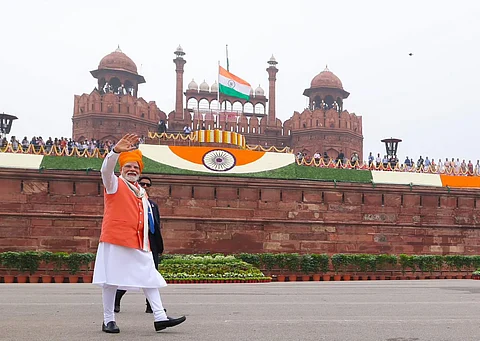
- Home
- न्यूजग्राम
- NewsGram USA
- India
- World
- Politics
- Entertainment
- Culture
- Lifestyle
- Economy
- Sports
- Sp. Coverage
- Misc.
- NewsGram Exclusive
- Jobs / Internships

In Independence Day speech, PM Modi announced next-generation GST reforms
Cutting slabs from four to three and reducing taxes on essentials, appliances, and services
The GST reforms will be rolled out by Diwali 2025
Prime Minister Narendra Modi, in his Independence Day address from the Red Fort, delivered what may have been his longest speech, starting at 7:30 a.m. and lasting 103 minutes. In his remarks, he paid tribute to India’s first prime minister and others who contributed to the nation, while also unveiling key reforms.
The most anticipated announcement was a major overhaul of the Goods and Services Tax (GST). Modi promised “next-generation GST reforms” to be introduced by Diwali 2025, calling it a “double Diwali gift” that would ease the tax burden nationwide.
Currently, GST has four slabs—5%, 12%, 18%, and 28%. The new structure will feature three: 5%, 18%, and a special 40% rate for luxury and sin goods. Nearly all items taxed at 12% will move to 5%, while most under 28% will shift to 18%. This means everyday essentials such as groceries, medicines, bicycles, furniture, and utensils will become cheaper. Luxury items and sin goods like cigarettes, cigars, and pan masala will be taxed at 40%, with the cess removed.
See Also: 10 Key Highlights from PM Modi’s Independence Day Speech
Appliances such as televisions and washing machines are also expected to see reduced tax rates. Agricultural tools, insurance, and education services will cost less under the new system. The proposal has been sent to the Group of Ministers (GoM) on GST rationalisation, while the GST Council—chaired by Finance Minister Nirmala Sitharaman—will meet in September to review the changes.
The reforms are built on three pillars: structural reforms, rate rationalisation, and ease of living. Structural reforms will correct inverted duty structures, resolve classification issues, and simplify compliance. Rate rationalisation will reduce taxes on common goods, improving affordability and boosting consumption. Ease of living measures will include simplified start up registration, pre-filled returns, and faster refunds.
According to the government, these reforms will lower the tax burden, raise affordability, and stimulate economic growth. Modi stated, “This Diwali will be a double Diwali. Citizens will receive a big gift as taxes on most goods fall.” Lower prices on daily-use items will ease household expenses, while MSMEs will benefit from reduced compliance.
In addition to GST reforms, Modi announced the Pradhan Mantri Viksit Bharat Rojgar Yojana, a ₹1 lakh crore initiative to boost private-sector employment. Under the scheme, young men and women entering their first private job will receive ₹15,000 directly from the government. Companies creating additional jobs will also get incentives. The programme is expected to generate 3.5 crore new employment opportunities nationwide.
The Prime Minister also emphasised technology as a key driver of growth. He said India had missed the semiconductor opportunity decades ago, calling it a “lost 50–60 years.” Now, the government is working in “mission mode” to build domestic chip-making capacity. Modi announced that Made-in-India semiconductor chips will be available by the end of 2025.
[Rh/VP]
Also Read:
